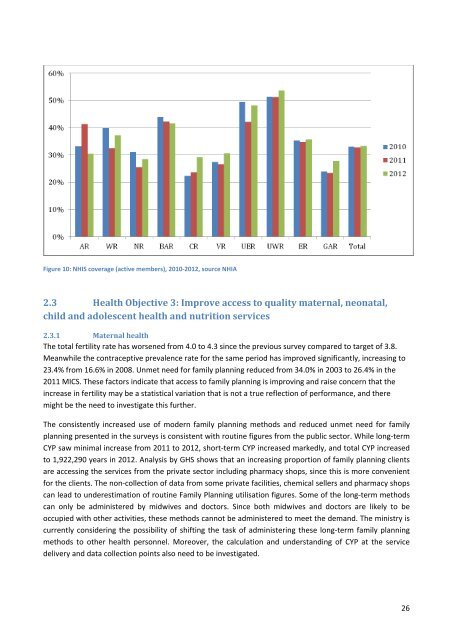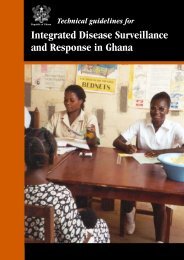2012 Holistic Assessment of Health Sector POW - Ministry of Health
2012 Holistic Assessment of Health Sector POW - Ministry of Health
2012 Holistic Assessment of Health Sector POW - Ministry of Health
You also want an ePaper? Increase the reach of your titles
YUMPU automatically turns print PDFs into web optimized ePapers that Google loves.
Figure 10: NHIS coverage (active members), 2010-<strong>2012</strong>, source NHIA<br />
2.3 <strong>Health</strong> Objective 3: Improve access to quality maternal, neonatal,<br />
child and adolescent health and nutrition services<br />
2.3.1 Maternal health<br />
The total fertility rate has worsened from 4.0 to 4.3 since the previous survey compared to target <strong>of</strong> 3.8.<br />
Meanwhile the contraceptive prevalence rate for the same period has improved significantly, increasing to<br />
23.4% from 16.6% in 2008. Unmet need for family planning reduced from 34.0% in 2003 to 26.4% in the<br />
2011 MICS. These factors indicate that access to family planning is improving and raise concern that the<br />
increase in fertility may be a statistical variation that is not a true reflection <strong>of</strong> performance, and there<br />
might be the need to investigate this further.<br />
The consistently increased use <strong>of</strong> modern family planning methods and reduced unmet need for family<br />
planning presented in the surveys is consistent with routine figures from the public sector. While long-term<br />
CYP saw minimal increase from 2011 to <strong>2012</strong>, short-term CYP increased markedly, and total CYP increased<br />
to 1,922,290 years in <strong>2012</strong>. Analysis by GHS shows that an increasing proportion <strong>of</strong> family planning clients<br />
are accessing the services from the private sector including pharmacy shops, since this is more convenient<br />
for the clients. The non-collection <strong>of</strong> data from some private facilities, chemical sellers and pharmacy shops<br />
can lead to underestimation <strong>of</strong> routine Family Planning utilisation figures. Some <strong>of</strong> the long-term methods<br />
can only be administered by midwives and doctors. Since both midwives and doctors are likely to be<br />
occupied with other activities, these methods cannot be administered to meet the demand. The ministry is<br />
currently considering the possibility <strong>of</strong> shifting the task <strong>of</strong> administering these long-term family planning<br />
methods to other health personnel. Moreover, the calculation and understanding <strong>of</strong> CYP at the service<br />
delivery and data collection points also need to be investigated.<br />
26















